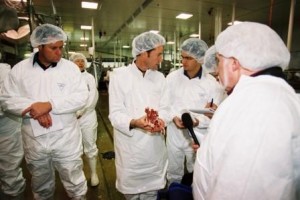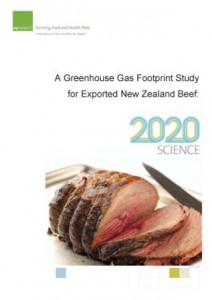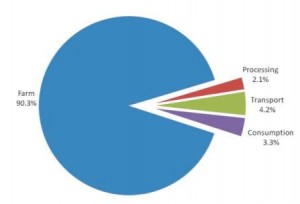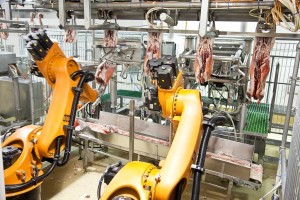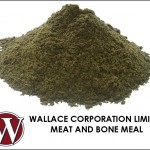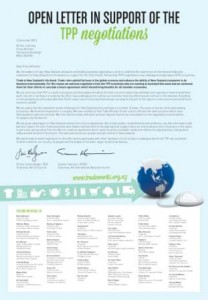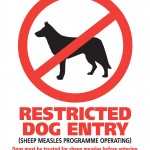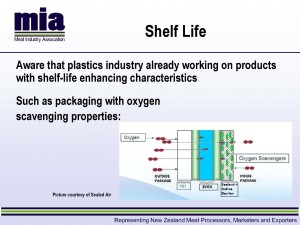 Lamb processor Craig Hickson was “chuffed” when he learned he was to be awarded the 2012 Allflex Federated Farmers Agribusiness Person of the Year in July. Adding a new Welsh meat plant to his business portfolio this year too, makes it one to remember in his business journey.
Lamb processor Craig Hickson was “chuffed” when he learned he was to be awarded the 2012 Allflex Federated Farmers Agribusiness Person of the Year in July. Adding a new Welsh meat plant to his business portfolio this year too, makes it one to remember in his business journey.
“It’s very pleasing to be recognised by your peers,” admits the managing director of Progressive Meats.
The astute Hawke’s Bay businessman’s speciality has lain in seeking solutions for plant processes that meet modern demands and also for challenging convention. Over most of the last 40 years (up to 2007) he has been in operation, the straight speaking Hickson has deliberately steered away from direct involvement in exporting leaving others to concentrate on that while he has focused on the niche of contract processing product for exporters.
Recognised as one of the meat industry’s leaders, he holds a seat on the Meat Industry Association (MIA) council and represents industry on the boards of Beef+Lamb NZ Ltd and the New Zealand Meat Board and an assorted array of other directorships.
Born in Canada to Kiwi parents, the young Craig Hickson was moved to Waipukurau when he was three months and later, at age seven, to Havelock North. His schooling was completed at Hastings Boys High, with vacations spent working at the Hawke’s Bay Farmers Meat Company Whakatu works, before he progressed on a HBMC scholarship to Massey University. There, he graduated with a B Tech in food technology, specialising in the engineering side – which has stood him in good stead through several new plants and plant renovations since. Later, he added a BA in economics and marketing to his list of accomplishments.
However, at that stage, pure food technology was not for the young red-headed Hawke’s Bay lad. In 1975, he found himself a job at the Meat Producers Board as product development officer, before leaving in 1980 to develop his own business – a small lamb packing plant in Hastings, Progressive Meats, which opened with his wife in October 1981.
In order to satisfy customer demand for contract services over the years, the Hicksons were involved with a few others in the ownership, design, planning, contruction and operation of Lamb Packers Feilding Ltd and Progressive Gisborne Ltd – and also with Lean Meats Oamaru through a minority shareholding in Lean Meats Ltd.
Having sold their 50 percent share in Feilding and Gisborne to Bernard Matthews NZ Ltd (BM) in 2005, Hickson was part of a syndicate that bought 100 percent back again in 2007 – the same slaughter and processing plant in Gisborne, and slaughter plant in Feilding plus a further processing plant in Waipukurau – when BM decided to withdraw from New Zealand to concentrate on its UK operations.
New meat plant in Wales
Matching supply to demand is also the reason for the purchase in April this year of a small Welsh meat processing plant Cig Calon Cymru (pronounced kig kalon – like talon – kumru, roughly translated as ‘Meat from the heart of Wales’), at Crosshands, near Lllanelli in South Wales. The plant is principally a beef processor, with a small lamb line.
Hickson explained that they had been looking for a suitable processing opportunity in the area to supply lamb year round to British consumers – the British and New Zealand lamb production is largely complementary for chilled. This enables New Zealand lamb to be supplied during the December to May period, when Welsh lamb is in short-supply and then Welsh lamb during the June to November period, when New Zealand lamb is in shorter supply benefiting both sets of producers. It will go into the same packaging with the country of origin clearly labelled.
The name of the company will remain as is and the plant will continue to process beef, but the branding for CCC product is yet to be determined. The management team will include New Zealander Jim Goodall who has the role of general manager. According to Hickson, plant staff are pleased that the company will have a new lease of life, while the local farmers are “reserving their judgement”.
Federated Farmers here have welcomed the initiative as it sees the move is an example of the vertical integration called for in several recent reports and shows there is life in New Zealand’s traditional markets. However, it is not novel, maintains Hickson pointing to Silver Fern Farms’ previous ownership of Brooks of Norwich, which enabled it to process frozen cuts to retailers’ exacting specification in-market, and other New Zealand companies, such as Alliance, Affco and Anzco, which have had in-market representation for many years and, in some instances, association with local processors.
He’s pleased there’s a ‘family’ connection too. The Hicksons own a 1,500ha farm in Hawke’s Bay and the farm manager’s wife, Denise, is Welsh, hailing from St Clairs which is near where the new plant is situated.
Slow product development
Hickson has observed very slow progress of new meat product development in terms of ready-to-eat products over the past four decades since his graduation.
“The major development area has been in the form of natural cuts and portion-size,” he says.
One fundamental reason he gives for the slow development of lamb ready meals is that lamb is a relatively high priced meat as a competing ingredient. Another is the fact that the nature of lamb fat means that it solidifies at a higher temperature than beef or pork making it tricky to work with. It is best served hot or cold, not warm.
One famous product victim of the rising price of lamb was the Bernard Matthews lamb roast, a frozen product that did very well in Britain. The concept was based on the company’s technology and marketing machinery for its famous turkey roast and was so successful it led to a plant being built here in Waipukurau to manufacture the lamb version.
The product did very well until the price of lamb increased beyond what this market segment would support, he explained, and volumes diminished to extinction. By then, BM had developed lines in chilled and frozen portion-controlled and weight-ranged lamb products for its range.
The new McDonald’s lamb burger, which has been trumpeted about recently, is one of only two examples of a commercial lamb ‘fast food’ item. The other being a doner kebab made from lamb flaps.
Contribution to processes
Hickson believes his most valuable contribution to industry has been to plant processes. Progressive Meats was at the forefront of changes to shiftwork, which though it had already been in place in the ‘follow on departments’ in plants, it was not utilised in slaughter and boning rooms. He gained union agreement in 1986, following a five week strike, just over a year before implementation in 1988.
“Shiftwork enabled small plants to be competitive, through the improved utilisation of capital,” he says.
It was its work on relationships with farmers that enabled Progressive to be the first company in 1987 to offer forward commitment arrangements for lamb supply. “At the time, other industry participants thought forward commitments were not viable and would fail,” Hickson said. But they didn’t.
Progressive was also one of the first companies to move away from the Meat Board’s grading system, which had been designed for carcase specifications, and adapt it for its own customers’ specifications for cuts.
“We talked to our farmers and encouraged them through payments to produce lambs to specification.”
After legislation changed to ban smoking in the workplace, he embarked on a lengthy court fight to establish whether a purpose-built, negatively-pressured smoking room next to the cafeteria at Progressive’s Hastings plant was outside the ‘workplace’. The challenge was lost, but had a silver lining.
“The legal wording was ambiguous and I thought, had the room been deemed not a workplace workers would not need to change clothes to go outside for a smoke, saving time, and their smoke wouldn’t disrupt other non-smoking employees.”
In the end, the court decided the room was ‘a workplace’ and workers did need to smoke outside the building. As Hickson himself is not a smoker, in fact he says he is “vitriocally opposed”, his support surprised his employees.
“Industrial relations have never been so good as just after that court decision,” he says, adding that the union financially contributed towards the defence of the case.
Looking to the future
Looking to the future, he commented that the Red Meat Sector Strategy (RMSS) is essentially a collation and synthesis of the views of industry participants.
“It didn’t deliver anything new but it is in a coherent form and advocates the development of future business along the lines of what, in many cases, is already going on,” he says.
However, ‘competition to buy’, tends to restrict the rate of progress to that of other competing companies in the field. While there is a high degree of consensus when interviewing participants one-on-one, it is a different matter when actions are observed in the cold commercial, competitive reality, he believes.
He sees the major challenge for the industry is for pastoral sheep, beef and deer farming to be a competitive land use option (at the margin) compared to dairying, forestry, viticulture and horticulture, among other uses.
“In 40 years, I’ve seen a dramatic change in the Hawke’s Bay Heretaunga plains, which was once prime finishing land for livestock and is now covered in apples, crops grapes, and other viticulture.”
Lifting prices is an obvious target, but is constrained by the fact that lamb is already a relatively high priced meat, he believes.
“Reduction in wastage getting the product to consumers is another target as is endeavouring to negotiate a larger share of what the consumer pays with supermarkets and food service people generally taking between 30 to 50 percent of what the consumer pays.”
“Sheep are a dual product animal and we neglect wool at our peril,” he says. ”We need to be actively seeking new applications to lift demand and hence returns, particularly for the mid-micron and strong wool,that are traditionally used in carpet making. Wool hasn’t kept pace with lambing percentage increases, or inflation and if we could arrest the decline, and reverse the trend, sheep farming will be more profitable and grow.”
During his spare time, hobbies include managing his 60 hectare farm around he and his wife’s home in Haumoana, where he keeps deer near to the house, “nice to look at and easy to keep.” He has a love of classic cars and still owns the first one he bought when he was 19, a 1954 MG TF. He plays tennis and cricket and enjoys sailing on Lake Taupo.
When asked what was his most proud moment over his career to date, Hickson paused to reflect and said he had difficulty picking one moment as they blend into each other.
“I’ve never felt as though I’ve climbed a mountain, I’ve always been on a journey.”
+++
Craig Hickson
- 1970 to 1973 – B Tech (Food), Massey University.
- 1973 – Management trainee at Hawke’s Bay Farmers Meat Company, Whakatu.
- 1975 – Joined Meat Producers Board staff as product development officer. Completed BA in Economics and Marketing Victoria University.
- 1981 – Hicksons start small meat packing house Progressive Meats.
- 1982 – Designs , builds and commissions small venison plant alongside Progressive Meats for ‘start up’ local farmer company, East Coast Venison.
- 1987 – Plan and design venison plant in Feilding for East Coast Venison.
- 1987 – Design, build and commision lamb slaughter at Progressive Hastings.
- 1990 – Takes a minority interest in Lean Meats Ltd.
- 1993 – Takes a minority interest in Te Kuiti Meats Ltd.
- 1994 – Buys venison plant in Hastings and, with partner John Signal, the venison plant in Feilding from Venison New Zealand (formerly East Coast Venison).
- 1995 – Builds Lamb Packers Feilding Ltd.
- 1998 – Builds Progressive Gisborne Ltd.
- 1999 – Builds replacement slaughter plant at Hastings (original only 13 years old).
- 2003 – A principal in setting up Progressive Leathers Ltd at Whakatu.
- 2005 – Sells Feilding and Gisborne Lamb interests to Bernard Matthews.
- 2006 – Takes a majority interest in Te Kuiti Meats Ltd.
- 2007 – Syndicate, including Hickson, purchases Bernard Matthews NZ Ltd’s lamb-processing and exporting operations in New Zealand and renames it Ovation New Zealand Ltd (plants at Gisborne, Waipukurau and Feilding).
- 2012 – Allflex Federated Farmers Agribusiness Person of the Year.
- 2012 – Hicksons purchase Welsh meat processor Cig Calon Cymru.
Current directorships: Progressive Meats Ltd, Ovation New Zealand Ltd, Lean Meats Ltd,Te Kuiti Meats Ltd, Progressive Leathers Ltd, MIA Council, Beef + Lamb NZ Ltd, Meat Board Ltd, Ovita Ltd. The Hicksons also farm sheep, beef and venison on 1,500 hectares in the Maraetotara/Elsthorpe district in East Coast Hawke’s Bay.
An abridged version of this article appeared in Food New Zealand magazine (October/November 2012).
 The new PGP programme, Collaboration for Sustainable Growth, announced yesterday is being welcomed by the industry.
The new PGP programme, Collaboration for Sustainable Growth, announced yesterday is being welcomed by the industry. Another programme partner Beef + Lamb NZ Ltd (B+LNZ)’s chairman Mike Petersen has also welcomed the initiative which he says “will be a huge boost for the sector and will accelerate progress in an increasingly collaborative approach across a range of issues that are important for sheep and beef farmers.”
Another programme partner Beef + Lamb NZ Ltd (B+LNZ)’s chairman Mike Petersen has also welcomed the initiative which he says “will be a huge boost for the sector and will accelerate progress in an increasingly collaborative approach across a range of issues that are important for sheep and beef farmers.”

